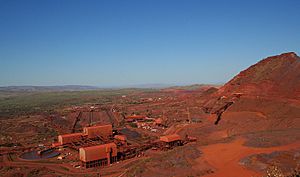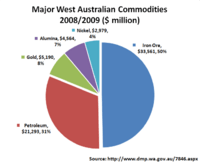Economy of Western Australia facts for kids
The Western Australian economy is all about how people in Western Australia make and spend money. It's mostly powered by its huge natural resources, like iron-ore, gold, and liquefied natural gas (LNG). It also relies a lot on services and farming products, especially wheat. Western Australia is Australia's biggest state, covering almost one-third of the country. About 2.6 million people live there, which is 11% of Australia's population.

Mount Tom Price mine: Iron-ore is the state's leading export commodity
|
|
| Currency | Australian dollar |
|---|---|
| Statistics | |
|
All values, unless otherwise stated, are in US dollars. |
|
In 2011, Western Australia sold almost half (46%) of all the goods Australia exported to other countries. By 2018-19, Western Australia's total economic output, called gross state product, was A$260.6 billion. This made it Australia's most productive state. It's also one of the richest places on Earth, with each person's share of the economy being A$135,479. This is much higher than the national average of A$74,605. In 2018-19, Western Australia sold A$147.1 billion worth of goods to other countries and bought A$34.1 billion. This created a huge trade surplus of A$112.95 billion, meaning they sold much more than they bought.
Contents
How the Economy Works
Main Activities
Western Australia's economy mostly runs on digging up and processing different minerals and petroleum (oil and gas). Because the state has so many natural resources, it's really good at getting them out of the ground and preparing them. This means:
- Western Australia uses more big machines and equipment in its industries than other states.
- The amount of goods and services produced per person is higher than in any other state.
- Over the last 15 years, the economy has become more varied. It now produces a wider range of goods. This means it doesn't rely on just a few things, which helps protect it when world prices change. For example, if oil prices are high, it helps make up for lower prices of other things like nickel.
- Service industries, like finance, insurance, and property, have grown a lot. The construction sector has also become a bigger part of the economy.
- Recently, countries like China (for iron-ore) and Japan (for LNG) have wanted more minerals and petroleum. This has helped Western Australia's economy grow faster than the rest of Australia.
Western Australia's exports to other countries made up 46% of Australia's total. The state's main exports include iron-ore, alumina, crude oil, LNG, nickel, gold, ammonia, wheat, wool, and live sheep and cattle. Western Australia is often called the "engine room" of the Australian economy.
Natural Resources
Western Australia is a major global producer of many natural resources. Australia is the world's biggest producer of bauxite and alumina, and half of this comes from Western Australia. For example, Alcoa's Huntly mine provides raw materials for its three processing plants. Western Australia is also the world's third-largest producer of iron-ore. It digs up 75% of Australia's 240 tonnes of gold.
Coal from Collie is used to make most of the electricity in the state's south-west. Australia is the fifth-largest exporter of LNG in the world, and most of it comes from the North West Shelf Venture near Karratha.
Because the resource sector has grown so much, there have been shortages of workers. The state government has tried to encourage people from other parts of Australia and overseas to move here. In February 2012, the average weekly income for a full-time adult in Western Australia was A$1,617.90. This was higher than the national average of A$1,406.80. The strong mining industry has also made property prices in Perth very high, second only to Sydney.
Farming
Farming in Western Australia is a big part of both the state and national economy. Even though it changes with the seasons, Western Australia produced almost 10 million tonnes of wheat in 2006-07. This was almost half of Australia's total and brought in A$1.7 billion from exports. Other important farm products include barley, peas, wool, lamb, and beef.
Many countries, especially in South East Asia and the Middle East, want to buy live animals from Western Australia. This is because of cultural and religious traditions, and sometimes a lack of good storage for processed meat. About half of Australia's live cattle exports come from Western Australia.
Wine
Western Australia has important wine-making areas in the South West. These include Margaret River, the Great Southern, and the Swan Valley. Many wineries make wine for people in Australia and for selling to other countries.
Fishing
Western Australia also has a big fishing industry. They catch and process things like Western Rock Lobsters, prawns, crabs, shark, and tuna for people to eat locally and for export.
Manufacturing
South of Perth is a large industrial area called Kwinana. Here, you'll find Australia's biggest oil refinery, which makes petrol and diesel. There's also an iron plant, and places that process alumina and nickel. The port facilities here are used for exporting grain. Many other businesses support the mining and petroleum industries, like engineering and metalwork.
Shipbuilding companies like Austal and Civmec are located nearby in Henderson, just south of Fremantle. Other important industries include making cement and building products, flour, food, animal feed, and fertilizers.
Tourism
In recent years, tourism has become more important. Many visitors come to Western Australia from the UK, other European countries, Singapore, Japan, and Malaysia. The number of tourists from China grew by 50% between 2011 and 2012. Money from tourism helps the economies of many smaller towns outside of Perth, especially those along the coast.
The number of international visitors to Western Australia is growing faster than the national average. For the year ending June 2011, there were 735,900 international visitors. They spent a total of A$1.94 billion, which was a 9.4% increase from the year before. This was also higher than the national average growth.
Overall, Western Australia had about 7,000,000 overnight visitors in 2012. Most of these (5,160,000) were from within the state, 1,112,000 were from other Australian states, and 760,800 were from overseas. This means Western Australia's tourism industry is worth about A$6 billion in total.
Economic History
Early Days (1829 to 1850)
The British Government started the Swan River Colony in 1829. They hoped it would become a farming and livestock colony. However, the land near the coast wasn't very good, and there weren't enough workers or roads. This made it hard for the economy to grow.
Convicts and Gold (1850 to 1913)
The Swan River colony was not meant to be a place for prisoners. But in 1848, the colony asked for convicts from Britain. They needed more workers and money from the British government. These convicts were all men, so a program was also started to bring in more women to balance the population. Before this, the population and economy had not grown much.
By 1870, the European population had tripled to about 20,000, with half of them being convicts. This allowed smaller businesses to start and reduced the need to buy things from other countries. The new workers helped build public projects. The colony slowly became more financially independent.
The discovery of gold during this time also made the population grow a lot. Many people moved from other Australian states and from overseas. Even though much of the money from gold went to the British Crown, some was used to build roads and other important things in the state. New towns like Coolgardie and Kalgoorlie were built near the goldfields. The remote northern town of Roebourne and its port Cossack also grew because of the gold boom. The city of Perth and the port of Fremantle, Western Australia also became busier.
World Wars and Hard Times (1913 to 1946)
World War I (1914–1918) made economic development difficult. While prices for farm products were high, there were also rising costs and not enough workers. The completion of the transcontinental railway in 1917 meant Western Australia became more connected to the rest of Australia and less dependent on Britain.
After the war, the state government tried to boost the economy by settling soldiers on farms in the south-west. This plan faced problems and cost the state a lot of money.
The Great Depression hit Western Australia hard because farming was so important. Prices for farm goods fell, leading to less demand, more unemployment, and much hardship. The economy only started to recover when farm prices began to rise again. Even so, unemployment in Western Australia stayed high until World War II began in 1939.
World War II had a much bigger impact than the first war. It quickly boosted industries and farming, ending the Depression. There was a severe shortage of workers that lasted into the 1950s. During the war, the government encouraged industrial growth in areas like Midland and Welshpool. Port facilities in Fremantle and air transport in Perth were also expanded for wartime needs. However, attacks by Japanese forces on northern Western Australia destroyed much of the infrastructure in towns like Wyndham, Derby, and Port Hedland.
After the War (1946 to Today)
After World War II, Western Australia's economy grew steadily. By the early 2000s, Western Australia was no longer seen as a "Cinderella State" (a state that was not as developed as others) within Australia. Instead, it became known as a major center for mining and farming, and a hub for exports.
In the years right after the war, Western Australia benefited greatly from the Australian government's increased involvement in the economy. New national airlines and shipping lines improved transport links with other states. A large immigration program started in 1946 helped with worker shortages and boosted the population. A housing agreement in 1947 allowed the state government to build many public houses, and Perth's metropolitan area doubled in size between 1945 and 1960. Also, an agreement was made with BP to build an oil refinery in the new industrial area of Kwinana.
When the federal ban on exporting iron-ore was lifted in 1960, it further boosted the economy. Growing industrial and mining production led to the growth of suburbs and consumerism in Perth and regional centers in the 1960s and 1970s. The government encouraged these developments. Money from foreign investment and increased taxes was used to modernize existing infrastructure. In the 1960s, a freeway system was built in Perth. New shopping centers were built, and Perth Airport was rebuilt.
While earlier governments focused on economic growth, later governments in the 1970s and 1980s focused more on education and social services. For example, they expanded the state high school system and funded a second state university. They also encouraged the development of regional centers by upgrading ports and mining communities.
Much of the economic growth in the 1960s and 1970s was supported by Japanese investors, especially in the iron-ore industry. American and British investors focused on farming and construction. From the 1990s, China became a major market for Western Australian goods and a potential investor. Major public works continued, and in the early 2000s, the Ord River Project in the north-west was completed. Perth's train and freeway networks also expanded rapidly.
In 2003, the State Government started a "Buy WA First" campaign to support the state's economy by encouraging people to buy local products.
Images for kids






